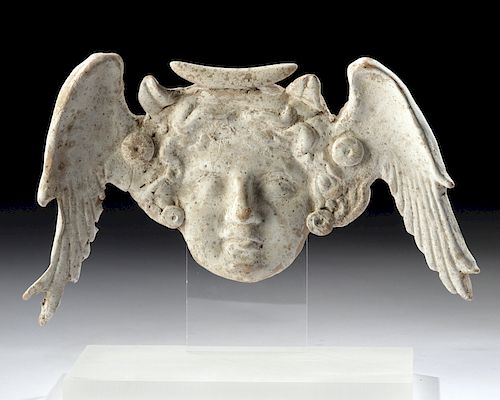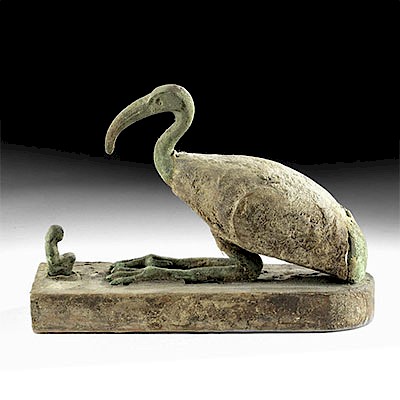Greek Canosan Pottery Winged Head Applique
Lot 42b
About Seller
Artemis Gallery
686 S Taylor Ave, Ste 106
Louisville, CO 80027
United States
Selling antiquities, ancient and ethnographic art online since 1993, Artemis Gallery specializes in Classical Antiquities (Egyptian, Greek, Roman, Near Eastern), Asian, Pre-Columbian, African / Tribal / Oceanographic art. Our extensive inventory includes pottery, stone, metal, wood, glass and textil...Read more
Estimate:
$2,000 - $3,000
Absentee vs Live bid
Two ways to bid:
- Leave a max absentee bid and the platform will bid on your behalf up to your maximum bid during the live auction.
- Bid live during the auction and your bids will be submitted real-time to the auctioneer.
Bid Increments
| Price | Bid Increment |
|---|---|
| $0 | $25 |
| $300 | $50 |
| $1,000 | $100 |
| $2,000 | $250 |
| $5,000 | $500 |
| $10,000 | $1,000 |
| $20,000 | $2,500 |
| $50,000 | $5,000 |
| $100,000 | $10,000 |
| $200,000 | $20,000 |
About Auction
By Artemis Gallery
Oct 31, 2019
Set Reminder
2019-10-31 10:00:00
2019-10-31 10:00:00
America/New_York
Bidsquare
Bidsquare : Fine Antiquities, Asian, Ethnographic Art
https://www.bidsquare.com/auctions/artemis-gallery/fine-antiquities-asian-ethnographic-art-4581
Our Halloween Day auction features classical antiquities, ancient and ethnographic art from cultures encompassing the globe, plus fine art. Artemis Gallery info@artemisgallery.com
Our Halloween Day auction features classical antiquities, ancient and ethnographic art from cultures encompassing the globe, plus fine art. Artemis Gallery info@artemisgallery.com
- Lot Description
Magna Graecia, Apulia, Canosan Hellenistic Period, ca. 4th to 3rd century BCE. A fascinating ceramic applique of a winged head, made to adorn a large vessel like an amphora. The head is that of either a youth or a woman with round earrings (the earrings may actually be decorative elements like the large applied circles above them), his or her face framed by curly hair parted at the center. Wide, staring eyes, a narrow nose, and a full-lipped, closed mouth complete the face, which is unlined. Wings project from its sides, each with delineated feathers. Two leaves and an elongated ovoid are at the top of the head. The back of the head is unpainted, but the back of the wings are painted, suggesting that while the head was attached, the wings reached outward. White paint covers the entire front of the sculpture, which was the Canosan style - white paint applied directly to buff pottery, with other colors then applied to the white. Size: 7.25" W x 4.5" H (18.4 cm x 11.4 cm); 5.5" H (14 cm) on included custom stand.
An isolated head is one of the most characteristic motifs on South Italic vases - for example, in the Museum of Metropolitan Art's collection of vases from Lucania, Apulia, Campania, Paestum, and Sicily, almost half of all vases have an isolated head motif. Their earliest appearances were ca. 400 BCE, when South Italic artwork began to diverge from that of Athens, developing into the distinctive local styles that would flourish for the next two centuries. At first, isolated heads only decorated small vases, but around 340 BCE, they began to appear on larger vases as well - as this impressive example must have. The winged head is a particularly interesting motif, and one that was most popular in Apulia. These heads are usually of ambiguous gender, as this one is. Researchers believe they may be Nike, Eros, or Amazons - or, indeed, that they may have been made deliberately ambiguous to sell to a variety of clients with many different beliefs about the afterlife in the vibrant cultural melting pot of Hellenistic southern Italy.
Provenance: private East Coast, USA collection; ex-private European collection, acquired in the 1970s
All items legal to buy/sell under U.S. Statute covering cultural patrimony Code 2600, CHAPTER 14, and are guaranteed to be as described or your money back.
A Certificate of Authenticity will accompany all winning bids.
We ship worldwide and handle all shipping in-house for your convenience.
#147929One wing is repaired. This is well done and unobtrusive, with no added pigment. Otherwise the head is in beautiful condition with nice remaining pigment and light deposits on its surface.Condition
- Shipping Info
-
All shipping is handled in-house for your convenience. Your invoice from Artemis Gallery will include shipping calculation instructions. If in doubt, please inquire BEFORE bidding for estimated shipping costs for individual items.
-
- Buyer's Premium



 EUR
EUR CAD
CAD AUD
AUD GBP
GBP MXN
MXN HKD
HKD CNY
CNY MYR
MYR SEK
SEK SGD
SGD CHF
CHF THB
THB














